임신 분만 백문백답, One hundred Qs & As on pregnancy and labor
Q & A. 성교 할 때마다 임신되나 Can they get pregnant after each sexual intercourse
- 그렇지 않다.
- 성교를 할 때 난자와 정자가 만날 수 없으면 임신 되지 않는다.
- 난자가 난관의 나팔관에서 정자를 만나려고 기다리고 있을 때 성교하면 임신이 될 가능성이 더 많다.
- 성교할 때는 난자가 난관 속에 정자를 기다리고 있지 않지만 성교를 한 후 1~2일 안에 배란 된 난자와 정자가 난관에서 만나면 임신 될 수 있다.
- 이와 같이 난자가 난소에서 배란되어 있는지 확실히 알기가 어렵다. 그러므로 성교를 하면 임신이 될 가능성이 있다고 생각하는 것이 좋다.
- 이런 이유로 성생활을 하는 부부가 임신되기를 원하지 않으면 평소 피임하고 수시로 성교 할 수 있다.
- 부모도 반의사가 되어야 한다–소아가정간호 백과]-제 3권 신생아, 영유아, 학령기와 사춘기 아이들의 성장발육. 제 10권 소아청소년 신장 비뇨 생식기계 질환. 제 14권 소아청소년 내분비 유전, 염색체, 대사, 희귀병 참조
Q & A. 첫 성교를 하거나 성교를 단 한번 해도 임신될 수 있나 If after only once sexual intercourse or the first sexual intercourse, can they get pregnant
- 그럴 수 있다.
- 첫 월경(초경)을 한 이후 월경 주기에 따라 배란을 하기도 하고 얼마동안 배란을 하지 않을 수 있다.
- 배란하는 사춘기 여아가 성교를 한번하든 처음하든 임신 될 수 있다.
- 그런데도 처음 성교를 하면 임신되지 않는다고 믿는 사춘기 아이들이 많다.
- 앉아서 성교 하거나 서서 성교하면 임신이 되지 않는다고 믿기도 한다.
- 그런 말은 틀린 말들이다.
- 성교하는 중 사정되기 전 남성의 자지를 여성의 질 강 속에서 빼고 질문 바깥 외부 생식기(외음부)에 사정하면 임신되지 않는다는 말도 있다. 그것도 틀린 말이다.
- 자지를 질 속에서 빼내기 전 사정을 하지 안 해도 성교하는 중 자지에서 정자가 조금 나올 수 있다.
- 따라서 성교 중 질 강 속에 사정하기 전 질 강 속에서 자지를 빼고 질문 바깥에 있는 외음부에 사정을 해도 임신이 될 수 있다.
- 부모도 반의사가 되어야 한다–소아가정간호 백과]-제 3권 신생아, 영유아, 학령기와 사춘기 아이들의 성장발육. 제 10권 소아청소년 신장 비뇨 생식기계 질환. 제 14권 소아청소년 내분비 유전, 염색체, 대사, 희귀병 참조
Q & A. 임신은 어떻게 되나 How to get pregnant
- 난자와 정자가 만나 수정란이 된다.
- 수정란이 자궁 내벽에 착상되면 임신이 될 수 있다.
- 여성의 난소에서 난자가 배란되고 남자의 고환에서는 정자가 생성되고 사정된 정자가 정관, 정낭, 요도를 통과해서 외 요도구로 나온다.
- 성교할 때 남성의 자지를 여성의 질 강 속에 넣고 정자가 든 정액이 사정되면 정액 속에 있는 정자는 자궁 속을 거쳐 난관 속으로 가서 난관의 맨 끝 부분 나팔관 속에서 난자를 만나면 수정이 되는 것이다.
- 그 수정된 난자 즉, 수정란이 자궁의 내벽에 착상되면 임신이 성립된다.
- 한 월경 주기에 한 개의 난자가 난소에서 나오는 것이 보통이다.
- 초경을 하기 전 사춘기 여아들이나 초경을 한 후 배란이 되지 않는 사춘기 여아들이나 폐경기 이후 여성들은 성교를 해도 임신이 되지 않는다.
- 난자가 배란되었지만 정자를 만날 수 없을 때 임신이 되지 않는다.
- 기초체온을 재서 난자가 난소에서 배란되는 날과 배란되는 시간을 어느 정도 확실히 알 수 있지만 배란되는 시각을 정확히 쉽게 알아내기가 사실상 어렵다.
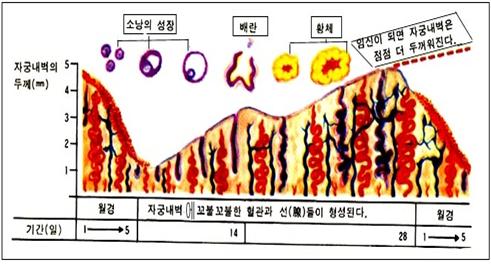
그림 1-47.월경 주기와 배란
출처-Carnation Company, Illustrations from Pregnancy in Anatomical과 소아가정간호백과
- 월경 출혈(Menstruation bleeding)은 3~7일간 계속되는 것이 보통이다.
- 월령 주기에 월경출혈을 며칠 간 한 후 바로, 거의 같은 방법으로 다음 월경 주기에 할 수 있는 월경 출혈 준비를 바로 하기 시작한다.
- 월경 주기(Menstruation phase)는 평균 28일이다.
- 월경 주기 동안에 임신이 성립되지 않거나, 어떤 건강 문제가 생기지 않는 한, 사춘기 여아들과 성인 여성들은 폐경기가 올 때까지 월경 출혈을 일정한 월경 주기를 두고 매 월경 주기에 며칠 동안 하게 된다.
- 초경을 한 이후 몇 개월 내지 몇 년 동안 지나면, 대부분의 사춘기 여아들과 여성들은 약 28일을 한 월경 주기로, 즉 약 28일 간격을 두고, 월경 출혈을 몇 일간 할 수 있다.
- 여성의 월경 축은 자궁, 난소, 뇌하수체 등으로 이루어진다.
- 한 여성에게 월경주기가 정상적으로 규칙적으로 계속되는 것은 월경 축에 있는 각 기관의 기능이 정상이라는 것을 간접적으로 알려준다.
- 초경을 한 이후 얼마 후 뇌하수체의 난포 자극 호르몬으로 난포가 자극받아 난포에서 한 달에 한 개의 난자가 배란된다.
- 난포에서 에스트로겐과 프로게스테론이란 여성 호르몬이 적절히 분비된다.
- 에스트로겐은 수정된 수정란이 자궁 내벽에 착상될 수 있도록 자궁 내벽을 적절히 만드는 작용을 한다.
- 월경 주기의 중간 날 한 개의 난자가 난포에서 나팔관 속으로 배란된다.
- 난자가 배란된 난포는 황체가 되고 그 황체에서 프로게스테론이 분비된다.
- 난포 프로게스테론은 태반 프로게스테론과 함께 자궁 내벽에 착상된 수정란이 계속 자라서 태아가 되고 그 태아가 계속 자랄 수 있게 돕는 역할을 한다.
- 난자가 정자를 만나 수정이 성립되지 않으면 임신이 성립되지 않는다. 그리고 자궁 내벽은 다음 월경 출혈을 시작하기 직전까지 점점 최대한도 얇아진다.
- 결국에는 자궁 내벽에 있는 혈관이 터지고 자궁내벽에서 출혈된다.
- 이런 생리적 출혈을 월경, 월경 출혈, 생리출혈, 또는 생리라고 한다.
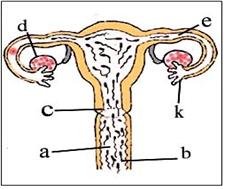
그림1-48. 여성 내부 생식기. 질강 속에 1회 사정된 3-5억 개의 정자가 난자를 찾아 난관 속으로 이동한다.
a-정자, b-질, c-자궁경부, d-난소, e-난관, k-나팔관
Copyright ⓒ 2012 John Sangwon Lee, MD., FAAP

그림 1-49. 여성 내부 생식기. 한 개의 난자가 한 개의 정자를 만나 한 개의 수정란이 된다. 그 수정란이 자궁내벽에 착상하기 위해 난관을 거쳐 자궁 속으로 이동한다. a-난소, b-수정란, c-자궁 강
Copyright ⓒ 2012 John Sangwon Lee, MD ., FAAP
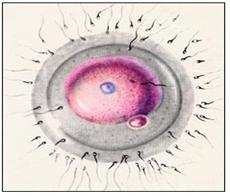
그림 1-50.난자와 정자가 만나 수정된 수정란
출처; Pregnancy in Anatomical Illustrations, Carnation Healthcare Servises와 소아간호백과
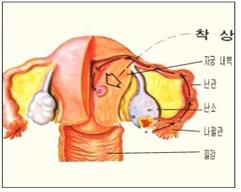
그림 1-51.난자와 정자가 만나 수정된 수정란이 자궁벽에 착상한다.
출처; Pregnancy in Anatomical Illustrations, Carnation Healthcare Servises과 소아가정간호백과
- 그러므로 피임 하지 않고 성교를 하면 임신이 될 수 있다고 믿는 것이 좋다. 어떤 부부는 피임하기 위해 부인이 피임약을 평소에 계속 먹는다.
- 부모도 반의사가 되어야 한다–소아가정간호 백과]-제 3권 신생아, 영유아, 학령기아, 사춘기아 성장 발육 육아, 제 10권 소아청소년 신장 비뇨 생식기계 질환. 제 14권 소아청소년 내분비 유전, 염색체, 대사, 희귀병. 제 25권 임신, 분만, 출산, 신생아 돌보기 참조.
Q & A. 몇 살 때부터 임신될 수 있나 What age is able to get pregnant
- 사춘기 여아들이 초경을 한 이후 성교하면 임신될 수 있다고 생각하는 것이 맞다.
- 어떤 사춘기 여아들은 8~9세에 첫 월경을 한다.
- 이런 사춘기 여아들과 성교하면 10세 전 여아도 임신 될 수 있다.
- 어떤 사춘기 여아들은 16세에 첫 월경을 할 수 있다.
- 첫 월경을 한 이후 성교하면 임신이 될 수 있다.
- 임신에서 신생아 돌보기까지 임신과 임부의 연령 참조 ,부모도 반의사가 되어야 한다–소아가정간호 백과]-제 3권 신생아, 영유아, 학령기아, 사춘기아 성장 발육 육아, 제 10권 소아청소년 신장 비뇨 생식기계 질환. 제 14권 소아청소년 내분비 유전, 염색체, 대사, 희귀병 참조
Q & A. 사춘기 여아가 사춘기 남아의 손을 잡거나 키스를 해도 임신되나 If a adolescent female holds a adolescent male’s hand or kisses, Is is possible to get pregnant
- 사춘기 여아가 사춘기 남아에게 키스를 하거나 남아의 손을 잡으면 임신되지 않는다.
- 부모도 반의사가 되어야 한다–소아가정간호 백과]-제 3권 신생아, 영유아, 학령기아, 사춘기아 성장 발육 육아. 제 10권 소아청소년 신장 비뇨 생식기계 질환. 제 14권 소아청소년 내분비 유전, 염색체, 대사, 희귀병. 제 25권 임신, 분만, 출산, 신생아 돌보기 참조
Q & A. 어떤 부부에게 임신이 되지 않는 이유 What are the reasons not to get pregnant in some couples
- 여러 가지 이유로 어떤 부부들에게는 임신이 잘 되고 어떤 부부들에게는 임신이 되지 않는다.
- 어떤 부부들은 임신이 될 수 있는 모든 조건을 다 구비되어 있지만 임신이 되지 않게 피임을 하기 때문에 임신되지 않는다.
- 어떤 부부들의 경우, 남편은 임신할 수 있는 모든 조건을 구비되어 있지만 부인의 난관이 막혀 임신이 될 수 없고, 어떤 부부들의 경우, 부인은 임신될 수 있지만 남편의 고환에서 임신될 수 있을 정도로 정자가 충분히 만들어지지 않기 때문에 임신이 되지 않을 수 있다.
- 그 외로 임신이 되지 않는 이유가 더 많이 있다.
- 부모도 반의사가 되어야 한다–소아가정간호 백과]-제 3권 신생아, 영유아, 학령기아, 사춘기아 성장 발육 육아. 제 10권 소아청소년 신장 비뇨 생식기계 질환. 제 14권 소아청소년 내분비 유전, 염색체, 대사, 희귀병. 제 25권 임신, 분만, 출산, 신생아 돌보기 참조.
Q & A. 3~4세 된 자녀가 엄마의 뱃속 어디에서 아기가 자라고 있나 질문하면 If a 3~4 year old child asks where a baby grows in my mom’s tummy
- 3~4세 된 자녀가 아기는 엄마의 뱃속에서 자란다는 것을 어느 정도 어렴풋이 알고 있지만 뱃속 어디에서 어떻게 자라고 있는지 정확히 모르는 것이 보통이다.
- 3~4세 된 유아가 엄마의 뱃속 어디에서 아기가 자라고 있느냐고 질문하면 “아기는 엄마의 뱃속에 있는 자궁 속에 있는 아기집에서 자란다.”라고 답변하면 된다. 참고로 이 질문은 전에도 있다.
- 부모도 반의사가 되어야 한다–소아가정간호 백과]-제 3권 신생아, 영유아, 학령기아, 사춘기아 성장 발육 육아. 제 10권 소아청소년 신장 비뇨 생식기계 질환. 제 14권 소아청소년 내분비 유전, 염색체, 대사, 희귀병 참조
Q & A. 자궁은 뱃속 어디에 있고 얼마나 큰가. Where is the uterus and how big is it
- 자궁은 여성의 배꼽 아래 부위에 있는 골반 강 속에 있다.
- 성인 여성의 자궁의 크기는 그 성인 여성의 주먹 크기만 하다.
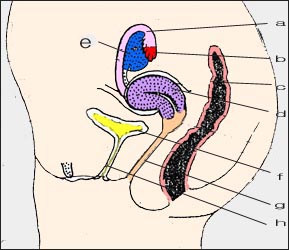
- 수정란이 자궁 내벽에 착상되어 자라서 성숙한 아기로 자란 후 태어날 때 쯤 자궁의 크기는 임신되지 안 했을 때의 자궁 크기의 20배 정도가 된다.
- 부모도 반의사가 되어야 한다–소아가정간호 백과]-제 3권 신생아, 영유아, 학령기아, 사춘기아 성장 발육 육아. 제 10권 소아청소년 신장 비뇨 생식기계 질환. 제 14권 소아청소년 내분비 유전, 염색체, 대사, 희귀병 참조
Q & A. 아기는 자궁 속에서 어떻게 자라나How does a baby grow in the womb
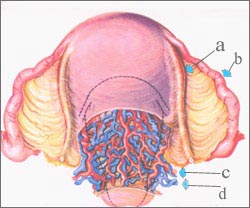
p2임신 3개월 된 자궁의 전면도
a-원형인대, b-난관, c-동맥, d-정맥
![]()
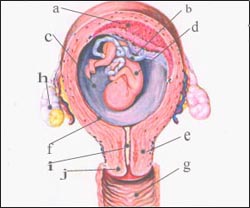
p3임신 3개월이 된 자궁 종단면
a-태반, b-탯줄, c-양수, d-태아, e-자궁경부, f-양막, g-질, h-난소, i-자궁경관, j-자궁경부
![]()
- 한 개의 정자와 한 개의 난자가 만나면 수정이 된다.
- 이 수정된 난자를 수정란이라 한다.
- 수정란이 자궁의 내벽에 착상될 수 있다.
- 착상되는 순간부터 수정란과 자궁 내벽 사이에 태반이 생긴다.
- 수정란은 자라서 태아가 된다.
- 태반은 태아와 자궁 내벽의 사이에 생긴다.
- 태아는 태반에 붙어 있는 탯줄을 통해 산소, 영양분, 수분 등 태아 생명을 유지하는데 필요한 모든 것을 엄마로부터 공급받고 자란다.
- 부모도 반의사가 되어야 한다–소아가정간호 백과]-제 3권 신생아, 영유아, 학령기와 사춘기 아이들의 성장발육. 제 10권 소아청소년 신장 비뇨 생식기계 질환. 제 14권 소아청소년 내분비 유전, 염색체, 대사, 희귀병. 제 25권 임신, 분만, 출산, 신생아 돌보기–태아의 성장발육 참조.
Q & A. 태반 Placenta
- 태반은 많은 핏줄들이 모여서 생긴 핏줄 덩어리이다. 손바닥과 같이 납작하고 두툼하게 생겼다.
- 태반의 크기는 임신 일수나 태아의 크기에 따라 다르다.
- 성숙한 아기가 태어날 때 태반의 크기는 성인의 손바닥 크기만 하다.
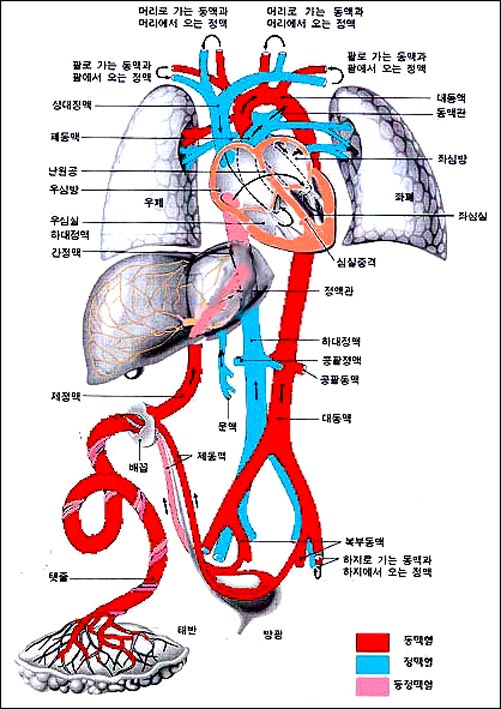
그림 10. 태아 심장 혈관 계통
소스; Used with permission from Ross Lab. Columbus Ohio와 소아가정간호백과

p4 임신 3개월이 된 자궁 종단면
a-태반, b-탯줄, c-양수, d-태아, e-자궁경부, f-양막, g-질, h-난소, i-자궁경관, j-자궁경부
![]()
- 태반의 한쪽 면은 태아 몸에 접촉되어 있고 그 반대쪽 면은 자궁 내벽에 붙어있다.
- 태아의 몸이 접촉되어 있는 쪽 태반에서 탯줄이 나온다.
- 부모도 반의사가 되어야 한다–소아가정간호 백과]-제 3권 신생아, 영유아, 학령기와 사춘기 아이들의 성장발육. 제 10권 소아청소년 신장 비뇨 생식기계 질환. 제 14권 소아청소년 내분비 유전, 염색체, 대사, 희귀병. 제 25권 임신, 분만, 출산, 신생아 돌보기 참조.
Q & A. 탯줄 Umbilical cord
- 탯줄은 태반에서 태아의 배꼽까지 연결되어 있고 교질로 형성된 육관이다.
- 아기는 탯줄에 있는 2개의 동맥과 한 개의 정맥을 통해 산소, 각종 영양분, 수분 등을 모체로부터 공급받고 자란다.
- 탯줄 속에 두 개의 동맥과 한 개의 정맥이 있다.
- 부모도 반의사가 되어야 한다–소아가정간호 백과]-제 3권 신생아, 영유아, 학령기와 사춘기 아이들의 성장발육. 제 10권 소아청소년 신장 비뇨 생식기계 질환. 제 14권 소아청소년 내분비 유전, 염색체, 대사, 희귀병. 제 25권 임신, 분만, 출산, 신생아 돌보기 참조.
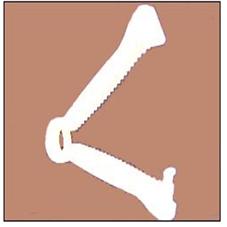
사진 323. 탯줄 클램프(탯줄 조이개)
Copyright ⓒ 2011 John Sangwon Lee, MD., FAAP
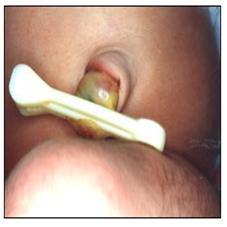
사진 324. 태어난 후 바로 클램프된 탯줄(탯줄 조이개)
Copyright ⓒ 2011 John Sangwon Lee, MD., FAAP
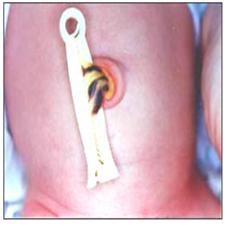
사진 325. 탯줄 건사
- 태어난 날 탯줄 클램프로 탯줄을 조인 후 탯줄이 건사되기 시작한다. 이제 3개의 탯줄 혈관이 보인다.
Copyright ⓒ 2013 John Sangwon Lee, MD., FAAP
Q & A. 탯줄 관리 Umbilical cord cares
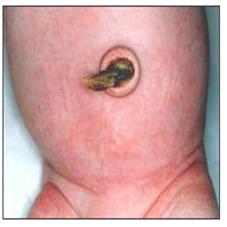
사진 326. 거의 완전히 건사된 탯줄
Copyright ⓒ 2013 John Sangwon Lee, MD, FAAP
- 아기가 태어나자마자 배꼽에서 약 3~5cm 떨어진 탯줄 부분을 의료용 실로 매든지 탯줄클램프로 클램프하고 살균된 가위로 그 부분을 자른다.
- 배꼽에 붙어 있는 탯줄 부분은 1~2주 내에 말라 배꼽에서 자연적으로 떨어진다.
- 마른 탯줄이 떨어진 배 피부에 배꼽이 생긴다.
- 부모도 반의사가 되어야 한다–소아가정간호 백과]-제 3권 신생아, 영유아, 학령기아, 사춘기아 성장 발육 육아, 제 10권 소아청소년 신장 비뇨 생식기계 질환. 제 14권 소아청소년 내분비 유전, 염색체, 대사, 희귀병. 제 25권 임신, 분만, 출산, 신생아 돌보기 참조
Q & A. 태아는 엄마의 자궁 속에서 운동을 하나 Does a baby exercise in the mom’s womb
- 태아도 엄마의 자궁 속에서 운동을 한다.
- 난자와 정자가 난관에서 만나서 수정란이 된다.
- 그 수정란이 자궁에 연결 되어있는 난관 속을 통과해서 자궁 속으로 이동한 다음 자궁 내벽에 착상된 후 임신이 되고 그 수정란은 배아가 된다.
- 그 배아는 점점 더 커서 태아가 되고 태아는 태어날 때까지 자궁 속 아기집에서 만삭 태아로 점점 더 성장 발육한다.
- 수정란이 자궁 내벽에 착상된 이후부터 아기(태아)는 태어날 때까지 계속 자라면서 때때로 운동을 한다.
- 임신 4~5개월경부터 임신부가 느낄 수 있을 정도로 태아는 엄마의 뱃속 자궁 속에서 현저히 움직인다. 태아가 엄마의 자궁 속에 움직이는 이것을 태동이라 한다.
- 자궁 속 태아가 점점 더 성숙되면서 엄마의 뱃속에 있는 자궁 속에서 팔다리를 폈다 오므렸다 운동하고 몸통을 이쪽저쪽으로 움직이기도 하고 하품 하고 손가락을 빨기도 하고 오줌을 싸기도 한다.
- 임신 5-6개월 된 임신한 임신부의 배 위에다 손을 한참동안 올려놓고 있으면 태아 아기가 꿈틀거리고 움직이고 노는 것을 손으로 감지할 수 있고 때로는 눈으로 엄마의 뱃가죽이 움직이는 것도 볼 수 있다.
- 만삭이 되어 태어날 때가 가까워지면 태아는 더 힘세게 움직인다.
- 때로는 덜 움직인다.
- 아기가 뱃속에서 움직여도 엄마는 아프지 않다.
- 분만 할 때에 아주 가까워지면 태아가 덜 움직인다.
- 그 이유는 모른다. 아마도 철이 나서 그런지 모른다.
- 아기집이 적어서 그럴 거다.
- 부모도 반의사가 되어야 한다–소아가정간호 백과]-제 25권 임신, 분만, 출산, 신생아 돌보기 참조
Q & A. 어떻게 해서 아들을 낳고 딸을 낳나 How do they get a boy or a girl
정상 남성 염색체 사진
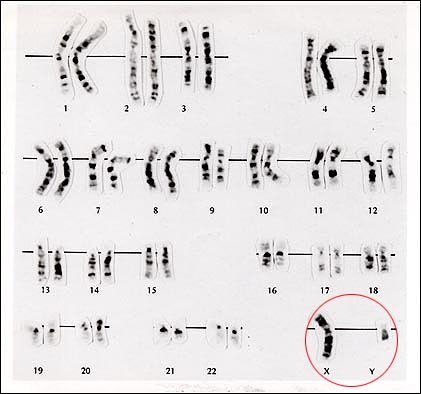
그림 1-221. 정상 남성 염색체
1-22번 염색체는 상염색체에 속하고 X Y 염색체(◯내)는 남성을 결정하는 성염색체라고 한다.
Dr. and Professor, Robert Greenstein, University of Conn Medical School.제공
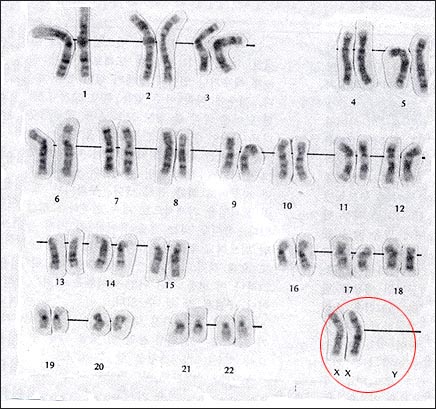
그림 1-222. 정상 여성 염색체
- 1-22번의 염색체는 상염색체에 속하고 X X 염색체(◯내)는 여성을 결정하는 성염색체이다.
- Dr. and Professor, Robert Greenstein, University of Conn Medical School 제공
- 여성의 난소에서 한 개의 난자가 한 월경 주기 동안에 나온다.
- 한번 사정될 때 남성의 고환에서 3~5 억 개의 정자들이 나온다.
- 수 억 개의 정자들 중 한 개의 정자가 한 개의 난자를 만나서 수정란이 되고 그 수정란이 아기가 된다.
- 남성 성염색체는 XY로 표시하고 여성 성염색체 는 XX로 표시한다.
- Y 성염색체에 의해 아들이 되든지 딸이 되는 것이 좌우된다.
- 즉 아기의 성염색체가 XY이면 아들이 되고 아기의 성염색체가 XX이면 딸이 된다.
- 난자와 정자가 만나 수정이 된 바로 그 순간부터 아들이 되고 또는 딸이 되는 것이 결정된다.
- 부모도 반의사가 되어야 한다–소아가정간호 백과]-제 25권 임신, 분만, 출산, 신생아 돌보기 참조.
Q & A. 태아가 뱃속에서 건강히 잘 자라게 하려면 임신부 자신은 건강관리를 어떻게 해야 하나 What kind of healthcare is the best for pregnant women to make babies growing well
- 태아에게 충분하고 균형 잡힌 영양분과 산소를 충분히 공급해 주기 위해 임신부는 균형 잡힌 음식물을 충분히 섭취하고 육체적 정신적 운동을 적당히 하고 신선한 공기를 마시고 정신적으로 육체적으로 편안히 쉬어야 한다.
- 요즘 흔히 쓰고 있는 타이레놀이나 그 외 다른 어떤 종류의 약물로 치료하든 그 약물 성분이 태반을 통과해서 태아의 핏속으로 들어가서 태아에게 해로울 수 있고 해롭지 않을 수 있다.
- 이런 이유로 임신부는 어떤 종류의 약물이든 약물로 치료 받기 전에 의사와 꼭 상의한 후 의사가 그 약물로 치료해도 괜찮다고 하면 치료해야 한다.
- 임신된 후부터 의사로부터 정기 임신 건강검진을 받고, 임신 중 건강관리를 잘 해야 한다.
- 임신 중 음주나 흡연을 피해야 한다.
- 부모도 반의사가 되어야 한다–소아가정간호 백과]-제 25권 임신, 분만, 출산, 신생아 돌보기 참조.
- Q & A. 태아는 엄마의 뱃속에서 영양공급과 산소를 어떻게 공급받나 How do babies get oxygen and nutrition in wombs
- 태아가 엄마의 뱃속에 있는 자궁 속에서 자랄 때 태반에서 아기의 배꼽까지 연결된 탯줄을 통해 산소와 영양분 등을 모체로부터 공급받는다.
- 임신부가 담배를 피우면 임신부의 자궁 속에 있는 태아도 담배를 피우고 임신부가 술을 마시면 임신부의 뱃속에 있는 태아도 술을 마신다고 생각하면 틀림없다.
- 임신부가 즐거워하면 뱃속 태아도 즐거워한다.
- 부모도 반의사가 되어야 한다–소아가정간호 백과]-제 25권 임신, 분만, 출산, 신생아 돌보기 참조.
Q & A. 엄마나 언니가 임신되고 분만하는 과정을 통해 소아 성교육을 할 수 있다. Child sex education can be done through mother’s or older sister’s pregnancy
- 엄마나 결혼한 언니가 임신돼서 뱃속에서 아기가 자라고 엄마의 배가 불러지고 뱃속 아기가 노는 태동이나 임신 중 건강관리를 하는 방법, 분만하고 산후회복이나 산후조리를 하는 것 등 임신 분만 과정을 통해 소아 성교육을 자녀들에게 많이 가르칠 수 있다.
- 부모도 반의사가 되어야 한다–소아가정간호 백과]-제 25권 임신, 분만, 출산, 신생아 돌보기 참조.
Q & A. 아기들은 어떻게 태어나나 How are babies born
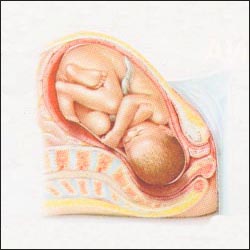
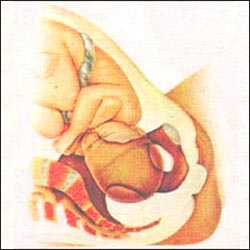
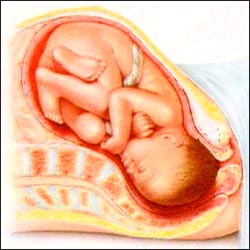
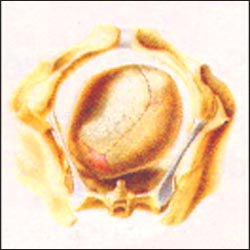
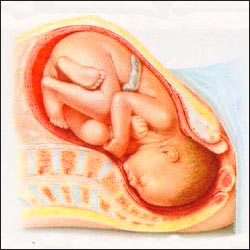
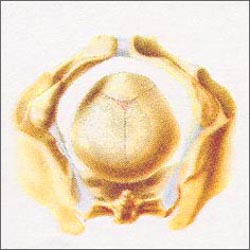
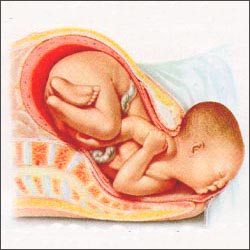
- 분만 2기이다. 산도에서 반곡태세가 완성됐고 아기의 얼굴은 엄마의 등을 향해 있고 자궁 경부는 완전히 말소되어 있고 자궁경관은 8-10 cm 정도 완전히 벌어져 있고 아기의 머리가 산도의 질구의 밖으로 거의 다 나와있다.
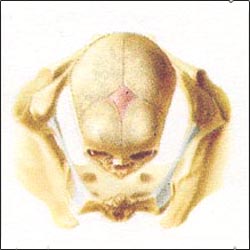
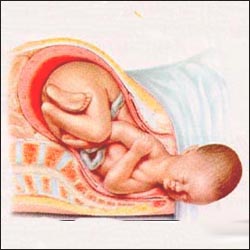
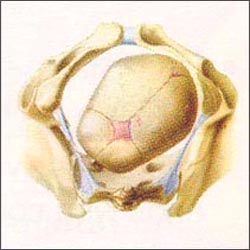
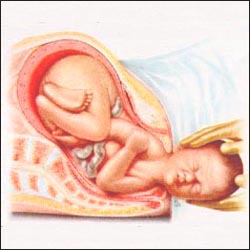
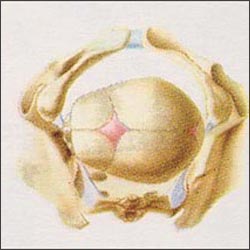
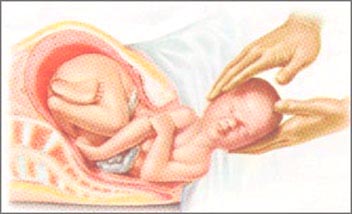
- 임신부의 자궁 속 아기집에서 자라던 아기(태아)가 다 자라서 만삭이 되면 자궁이 수축되고 진통이 시작된다.
- 이때 아기는 질산도(산도)을 통과해서 이 세상에 태어난다.
- 아기가 태어날 때 자궁이 여러 번 수축된다.
- 대부분의 아기들은 이렇게 자연적으로 산도를 통해 태어난다.
- 부모도 반의사가 되어야 한다–소아가정간호 백과]-제 25권 임신, 분만, 출산, 신생아 돌보기 참조)
Q & A. 산도 Birth canal
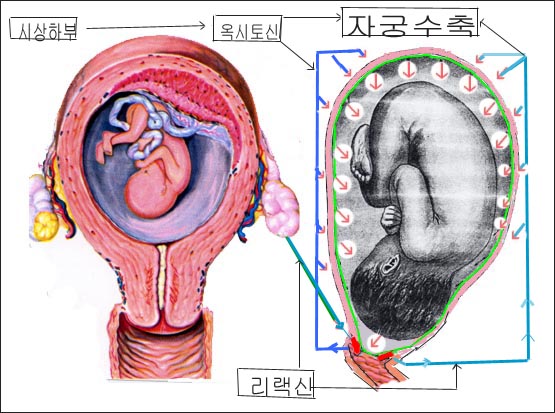
- 자궁 속에 있던 아기는 자궁경부의 경관 속과 질 강 속을 통해서 태어난다.
- 자궁의 경부의 경관 속과 질 강 속을 산도라고 한다.
- 부모도 반의사가 되어야 한다–소아가정간호 백과]-제 3권 신생아, 영유아, 학령기와 사춘기 아이들의 성장발육. 제 10권 소아청소년 신장 비뇨 생식기계 질환. 제 14권 소아청소년 내분비 유전, 염색체, 희귀병. 제 25권 임신, 분만, 출산, 신생아 돌보기 참조.
Q & A. 제왕절개 수술 분만 Caesarean section delivery
- 어떤 경우, 아기가 자궁 경관 속과 질산도 속을 통과해서 자연적으로 태어날 수 없다.
- 이런 때는 의사가 임신부에게 척추마취를 하거나 다른 종류의 마취를 한 후 임신부의 복벽과 자궁벽을 수술 칼로 째어 만든 산도를 통해서 아기를 자궁 밖으로 꺼내 분만 시킨다.
- 아기를 자궁 속에서 꺼낸 후 짼 모체 복벽과 자궁벽을 수술바늘로 꿰맨다. 이렇게 아기 낳는 분만을 제왕절개 수술분만이라고 한다.
- 부모도 반의사가 되어야 한다–소아가정간호 백과]-제 3권 신생아, 영유아, 학령기와 사춘기 아이들의 성장발육. 제 10권 소아청소년 신장 비뇨 생식기계 질환. 제 14권 소아청소년 내분비 유전, 염색체, 대사, 희귀병. 제 25권 임신, 분만, 출산, 신생아 돌보기–제왕절개 수술분만까지 참조.
Q & A. 진통(산통) Pain in labor
- 분만 중 자궁이 수축될 때 생기는 통증을 진통, 또는 산통이라고 한다.
- 아기를 낳을 때 모든 분만부들에게 진통이 온다. 그러나 어떤 분만부들에게 진통이 더 많이 오고 다른 어떤 분만부들에게 진통이 덜 온다.
- 어떤 분만부들은 진통이 많이 와도 꾹 참고 견디면서 분만하고 어떤 분만부들은 진통이 올 때 아프다고 말하는 대신 병원이 다 떠나갈 정도 큰 소리를 지르기도 한다. 이런 진통도 아기를 낳은 후 곧 싹 가신다.
- 부모도 반의사가 되어야 한다–소아가정간호 백과]-제 3권 신생아, 영유아, 학령기아, 사춘기아 성장 발육 육아. 제 10권 소아청소년 신장 비뇨 생식기계 질환. 제 14권 소아청소년 내분비 유전, 염색체, 대사, 희귀병. 제 25권 임신, 분만, 출산, 신생아 돌보기–이제 진통이 시작된다. 참조
Q & A. 임신 분만 교육이 필요한가 Is it necessary to get childbirth education class
- 분만이 시작되면 그동안 태아가 살고 있던 자궁이 여러 번 수축되면서 태아가 산도 속을 통과해서 자연적으로 이 세상으로 태어난다.
- 자궁이 수축될 때마다 배가 아픈 것이 보통이다.
- 대부분의 분만부들은 진통을 잘 견딘다.
- 임신 중 자연 분만을 하는 법을 임신 분만클래스 교육을 통해 잘 배워 분만 중 자궁이 수축될 때마다 자궁 수축 리듬에 호흡 리듬을 잘 맞추면 진통으로 생기는 아픔이 훨씬 덜하고 분만을 쉽게 할 수 있다.
- 아기가 산도를 통해서 분만된 바로 후부터 진통이 더 이상 생기지 않는 것이 보통이다. 그러나 태반이 나올 때 배가 조금 아플 수 있다. 이것을 훗배라고 한다. 이런 분만 과정을 잘 이해하면 분만을 더 쉽게 할 수 있다.
- 부모도 반의사가 되어야 한다–소아가정간호 백과]-제 3권 신생아, 영유아, 학령기아, 사춘기아 성장 발육 육아. 제 10권 소아청소년 신장 비뇨 생식기계 질환. 제 14권 소아청소년 내분비 유전, 염색체, 대사, 희귀병. 제 25권 임신, 분만, 출산, 신생아 돌보기 참조
Q & A. 아기가 산도를 통과해 자연분만이 되지 않으면 어떻게 아기를 낳나 If a baby can not be born through the natural birth canal, how to delivery a baby
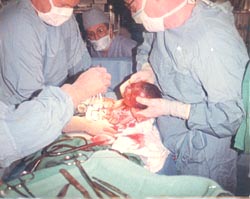
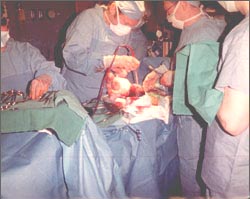
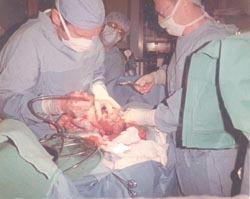
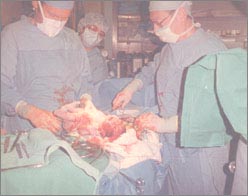
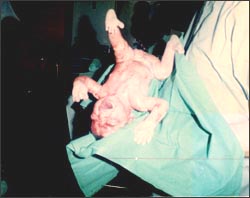
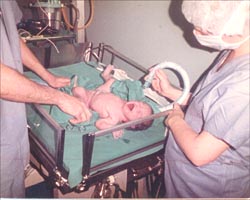
- 어떤 이유로든 자궁 경관 속 산도와 질 산도 속을 통해 자연분만을 할 수 없을 때는 임신부의 복벽과 자궁벽을 수술로 째서 수술로 만든 산도를 통해서 아기를 자궁 속에서 꺼낸다. 이런 분만을 제왕절개 수술분만이라고 한다.
- 겸자 분만 방법으로 자연산도 속을 통해 아기를 꺼낼 수 있다.
- 부모도 반의사가 되어야 한다–소아가정간호 백과]-제 3권 신생아, 영유아, 학령기아, 사춘기아 성장 발육 육아. 제 10권 소아청소년 신장 비뇨 생식기계 질환. 제 14권 소아청소년 내분비 유전, 염색체, 대사, 희귀병. 제 25권 임신, 분만, 출산, 신생아 돌보기–진통이 시작된다.
Q & A. 아기의 부모가 되기 위해서 어떤 준비가 필요하나 To become parents for a baby
- 임신하고 분만해서 아기를 낳고 아기의 부모가 된다는 그 자체는 퍽 경사스런 일이다.
- 자식을 진심으로 조건 없이 사랑하면서 양육해서 키우는 맛도 여간 아니다.
- 그렇지만 자녀를 잘 양육한다는 것은 쉽지 않다.
- 자녀를 양육할 때 상상 이상으로 많은 일들이 따르기 때문이다.
- 자연섭리에 따라 아기를 임신하고 낳는 본능 이외 다른 많은 이유로 아기를 갖는다.
- 자식을 가진 부모들은 자식을 사랑하고 그들과 사는 동안 즐거움도 이만저만 하다.
- 부모들은 자식을 조건 없이 진정으로 사랑해 양육해야 하는 의무와 책임도 있다.
- 그 외로 자녀들이 필요로 하는 의식주, 건강관리, 사랑, 충분한 잠, 교육 등을 그들에게 적절히 제공하고 그들의 안녕을 절대적으로 1차적 책임을 져야 한다.
- 부모로서 이런 일을 수행한다는 것은 여간 힘든 일이 아니다. 그러나 사랑해서 자녀 키우는 즐거움은 헤아릴 수 없다.
- 좋은 부모가 되고 자녀를 잘 양육하기 위해서 언제 아기를 임신하고 출산할 것인가를 충분히 검토하고 계획해서 임신하고 출산해야 한다.
- 부모도 반의사가 되어야 한다–소아가정간호 백과]-제 3권 신생아, 영유아, 학령기와 사춘기 아이들의 성장발육. 제 10권 소아청소년 신장 비뇨 생식기계 질환. 제 14권 소아청소년 내분비 유전, 염색체, 대사, 희귀병. 제 25권 임신, 분만, 출산, 신생아 돌보기–진통이 시작된다.
Q & A. 인공 수정 Artificial fertilization
- 수정이 남녀가 성교해서 자연적으로 되는 것이 아니라 수정을 인공적으로 시키는 것을 인공수정이라 한다.
- 결혼한 대부분의 부부들은 성교를 하고, 성교를 한 후 남편의 정자와 부인의 난자가 난관 속에서 만나 자연적으로 수정되고 그리고 임신이 성립된다.
- 수정란이 자라 배아가 되고 그 배아가 자라 태아가 되고 태아가 자라서 아기가 태어난다.
- 일부의 부부들에게는 여러 가지 원인으로 인해 수정이 되지 않고 물론 임신도 될 수 없다.
- 이런 현상을 불임이라 한다.
- 임신을 할 수 없는 여러 가지 원인들 중 가장 흔한 원인은 부인의 난관이 어떤 이유로 막혀 난소에서 나온 난자와 남성의 고환에서 나온 정자가 서로 만날 수 없어 수정이 되지 않는 것이다.
- 다른 불임의 원인은 남편의 정자의 수가 임신될 수 없을 정도로 충분치 않기 때문이다. 그 외로 임신이 되지 않는 이유가 많다.
- 임신되지 않으면 부부는 의사의 정밀한 진찰 진단을 받아야 한다.
- 난관이 막혔으면 막힌 난관의 부분이 소통되게 하는 난관 소통 수술을 받을 수 있다.
- 남편의 정자수가 비정상으로 적어 임신이 되지 않으면 남편의 정자를 모아 정자들을 부인의 자궁 속에 직접 주입해서 임신되게 하는 방법도 있다.
- 이 방법으로 수정시키는 것도 일종의 인공수정이다.
- 어떤 남편들은 정자를 전혀 만들 수 없다. 그런 때는 남편이 사정한 정액 속에 정자가 하나도 없다. 이런 경우, 부인이 임신될 수 없다.
- 드물게는 남성이 만드는 정자의 수는 충분하지만 그 정자들이 비정상적 정자들일 수 있다. 이런 부부의 경우 정상적인 난자와 비정상적인 정자가 만나서 수정이 될 수 없고 임신도 되지 않는다. 이런 경우도 다른 남성의 정자를 얻어 튜브를 통해서 다른 남자의 정자를 부인의 자궁 속에 인공으로 넣어서 아기를 배게 할 수 있는 인공수정 방법도 있다.



- 부인이 난자를 만들어 낼 수 없어 아기를 밸 수 없으면 남편의 정자를 다른 여성의 난자와 테스트 튜브 속에서 인공으로 수정시킨 다음 그 수정란을 자기 부인 자궁 속에 넣어서 자기 부인의 자궁 속에서 아기가 자라게 해서 아기를 낳을 수도 있는 인공수정 방법도 있다.
- 때로는 남편의 정자와 부인의 난자를 시험관 속에서 수정시킨 후 그 수정란을 부인의 자궁에
- 넣어 임신시킬 수 있다. 이런 임신을 시험관 임신이라고 한다.
- 부모도 반의사가 되어야 한다–소아가정간호 백과]-제 3권 신생아, 영유아, 학령기와 사춘기 아이들의 성장발육. 제 10권 소아청소년 신장 비뇨 생식기계 질환. 제 14권 소아청소년 내분
- 비 유전, 염색체 대사, 희귀병. 제 25권 임신, 분만, 출산, 신생아 돌보기–진통이 시작된다. 참조.
Q & A. 아기를 낳을 수 없는 부부는 어떻게 임신할 수 있나 If the couple are unable to get pregnant, how to get help for pregnancy
- 부부가 아기를 임신 할 수 없고 물론 낳을 수 없으면 남편이나 부인 중 임신이 되지 않는 이유를 알기 위해 의사와 상담하고 진찰진단 치료를 받아야 한다.
- 만일 부인의 난관이 막혀 난자와 정자가 만날 수 없어 임신이 되지 않으면 난관 소통수술을 받을 수 있다.
- 남편의 정자 수가 적어서 임신이 되지 않으면 남편의 정자를 많이 모아 그 정자를 부인의 질강 속에 넣어 직접 자연 임신이 되게 할 수 있다.
- 만일 남자가 정자를 만들어 내지 못해 임신이 되지 않으면 다른 남자의 정자와 부인의 난자를 체외에서 인공수정을 시킨 후 그 수정란은 부인의 자궁 속에 넣어 부인이 아기를 밸 수 있게 할 수 있다.
- 자궁이 없거나 어떤 다른 이유로 부인이 임신할 수 없으면 남편의 정자를 어떤 여성의 난자와 체외 인공수정을 시켜 자기 부인대신 다른 여성이 자기 아기를 배는 방법도 있다.
- 부모도 반의사가 되어야 한다–소아가정간호 백과]-제 3권 신생아, 영유아, 학령기아, 사춘기아 성장 발육 육아. 제 10권 소아청소년 신장 비뇨 생식기계 질환. 제 14권 소아청소년 내분비 유전, 염색체, 대사, 희귀병. 제 25권 임신, 분만, 출산, 신생아 돌보기–진통이 시작된다.
Q & A. 사춘기 여아가 임신하는 이유 What are the reasons for adolescent females to get pregnancy
- 결혼을 하지 않은 사춘기 여아들이 여러 가지의 이유로 임신할 수 있다.
- 어떻게 하면 임신되는지, 피임을 어떻게 하는지 등 임신에 관한 지식과 상식이 전혀 없는 어떤 사춘기 여아가 성관계를 무분별적으로 한 후 임신이 될 수 있다.
- 어떤 사춘기 여아는 성에 관한 잘못 된 지식과 정보를 가지고 있기 때문에 임신이 될 수 있다.
- 어떤 사춘기 여아는 여러 가지 이유로 임신하고 싶고 아기를 낳고 싶고 사랑하고 싶은 생각이 있어 일부러 임신할 수 있다.
- 소아 성 학대를 받고 원치 않는 임신이 될 수 있다.
- 피임을 잘못해서 임신이 될 수 있다.
- 결혼한 후 계획적으로 임신할 수 있다
- 부모도 반의사가 되어야 한다–소아가정간호 백과]-제 3권 신생아, 영유아, 학령기아, 사춘기아 성장 발육 육아. 제 10권 소아청소년 신장 비뇨 생식기계 질환. 제 14권 소아청소년 내분비 유전, 염색체, 대사, 희귀병. 제 25권 임신, 분만, 출산, 신생아 돌보기–진통이 시작된다.
- Q & A. 미혼 10대 여아가 임신될 수 있나 Can a single female teenager get pregnant
- 10대 사춘기 남녀아들이 사교하기 위해서 만나고 데이트를 시작할 수 있다.
- 그러나 10대 사춘기 남녀아들이 데이트를 하는 중 자연적으로 성 욕구가 충만해질 수 있다.
- 이때 그들은 손을 잡고 서로 신체 접촉을 하기 시작하고 그 다음 허그하고 그다음 키스하고 애무하고 손으로 속 옷 밑 살을 만지면서 애무하게 된다.
- 이때쯤 더 이상 참을 수 없을 정도로 성욕이 충만할 지경에 이르게 될 때도 있다.
- 그래서 계획하지 않은 성교까지 하게 될 수 있다.
- 10대 사춘기 남녀아들의 데이트의 결과의 하나의 가상적인 예이다.
- 피임약으로 피임을 하지 않은 상태에서 처음으로 단 한번 한 성교로 인해 임신이 될 수 있고 그 임신으로 그들의 삶에 큰 변화가 생길 수 있다.
- 그렇게 해서 10대 미혼모가 될 수 있다.
- 이런 예는 요즘 세상에 사실 허다하다.
- 부모들은 가정 정규 소아 성교육을 통해 그들이 자랄 때 그들에게 올바른 성 가치관을 확립시켜 주어야 한다.
- 자녀가 10대 미혼모가 되지 않게 데이트 하는 법, 성교를 하지 않고 금기하는 방법, 임신이 되지 않게 피임하는 방법 등을 가정 정규 소아 성교육이나 학교 정교 소아 성교육 과정을 통해 미리 가르쳐 주어야 한다.
- 적절한 나이에 데이트를 시작하도록 소아 성교육을 시켜야 한다.
- 부모도 반의사가 되어야 한다–소아가정간호 백과]-제 3권 신생아, 영유아, 학령기아, 사춘기아 성장 발육 육아. 제 10권 소아청소년 신장 비뇨 생식기계 질환. 제 14권 소아청소년 내분비 유전, 염색체, 대사, 희귀병. 제 25권 임신, 분만, 출산, 신생아 돌보기–진통이 시작된다.
Q & A. 미혼 10대 여아가 아기를 낳으면 If a single female teenager gives a baby
- 미혼 10대 여아가 아기를 배고 분만하면 여러 가지 문제가 그 10대 여아, 그녀의 가정, 그 사회에 심지어는 그 나라에도 생길 수 있다.
- 그 10대 미혼 여아 자신이 자기 아기를 양육하든지 남에게 맡기어 양육하든지 양자로 보내서 아기를 양육해야 하는 문제가 제일 먼저 생긴다.
- 아기가 태어나기 전 임신중절 시킬 수 있다. 이 경우, 그 10대 미혼 여는 일생 동안 죄의식 감을 가지고 살 수 있고 10대 여아에게 지대한 정신 건강상 문제가 생길 수 있다. 나아서는 가정, 사회, 국가에게 지대한 부담이 된다.
- 임신되지 않게 하는 가장 좋은 방법은 성교를 절제하는 금기 방법이다.
- 그러나 사실은 이 방법은 가장 어려운 피임 방법이다.
- 그래서 다른 방법으로 피임을 적절히 해야 한다.
- 범국가적 차원에서 미혼 10대 남여아 임신을 잘 예방하는 것이 정치가들의 미이고 사회 복지 정책이다.
- 부모도 반의사가 되어야 한다–소아가정간호 백과]-제 3권 신생아, 영유아, 학령기아, 사춘기아 성장 발육 육아. 제 10권 소아청소년 신장 비뇨 생식기계 질환. 제 14권 소아청소년 내분비 유전, 염색체, 대사, 희귀병. 제 25권 임신, 분만, 출산, 신생아 돌보기–진통이 시작된다, 미혼녀가 임신했을 때의 문제점.
Q & A. 미혼 10대 여아들이 임신되면 If a single female teenager gets pregnant
- 미혼 10대 여아들이 임신되면 아기를 낳아 키우든지 낳은 아기를 양자 시키든지 인공 임신중절을 할 수 있다.
- 이 3가지 방법 중 어떤 한가지의 방법을 택하든 그 10대 여아의 생애에 정신적으로 지대한 부정적으로 변화가 생길 수 있다.
- 임신 중 학교 공부 문제도 생길 수 있고 태어난 아기를 양자 시키거나 임신 중 낙태시키면 또한 일생동안 정신적 상처를 크게 입을 수 있다.
- 임신이 되지 않게 성교를 하지 않던지 피임으로 임신되지 않게 하는 방법도 있다.
- 부모도 반의사가 되어야 한다–소아가정간호 백과]-제 3권 신생아, 영유아, 학령기아, 사춘기아 성장 발육 육아. 제 10권 소아청소년 신장 비뇨 생식기계 질환. 제 14권 소아청소년 내분비 유전, 염색체, 대사, 희귀병. 제 25권 임신, 분만, 출산, 신생아 돌보기–진통이 시작된다.
Q & A. 사춘기 아이들이 임신되고 아기의 부모가 되기 전에 꼭 알아야 할 것들 Things which all adolescents must know before pregnancy and delivery
- 아기를 배고 낳아서 좋은 부모들이 된다는 그 자체가 퍽 경사스런 일이다.
- 자녀를 조건 없이 진심으로 사랑하면서 잘 양육해서 자녀를 성인으로 키우는 부모의 책임과 노릇도 여간 아니다.
- 그렇지만 부모가 자녀를 양육하는 데는 보통으로 생각하고 상상하는 것보다 훨씬 더 많은 희로애락이 따른다.
- 당연히 따른다.
- 그들을 조건 없이 진심으로 사랑해야 하는 것은 물론이고 그들이 필요로 하는 의식주, 건강관리 등 여러 가지 인간의 기본 필수 조건들을 충족시켜 주는 데 부모는 전적으로 책임져야 한다.
- 좋은 부모가 되고 좋은 자녀들을 양육하기 위해 언제 아기를 가질 것인가 충분히 검토하고 계획해서 임신하고 출산해야 한다.
- 부모도 반의사가 되어야 한다–소아가정간호 백과]-제 3권 신생아, 영유아, 학령기아, 사춘기아 성장 발육 육아. 제 10권 소아청소년 신장 비뇨 생식기계 질환. 제 14권 소아청소년 내분비 유전, 염색체, 대사, 희귀병. 제 25권 임신, 분만, 출산, 신생아 돌보기–진통이 시작된다.
Q & A. 임신됐을 때 어떻게 임신을 중절 하나 After pregnancy, how do you interrupt pregnancy
- 태아가 자궁 속에서 점점 더 성숙돼서 아기가 이 세상에 태어나기 전 아기가 자궁 속에서 더 이상 자라지 못하게 의학적으로 임신을 중단하는 치료를 임신중절이라고 한다.
- 임신 중절수술을 받은 후 임신부와 가족은 여러 면에서 부정적으로 영향을 받을 수 있다.
- 저자는 임신 중절을 적극적으로 반대한다.
- 부모도 반의사가 되어야 한다–소아가정간호 백과]-제 3권 신생아, 영유아, 학령기아, 사춘기아 성장 발육 육아. 제 10권 소아청소년 신장 비뇨 생식기계 질환. 제 14권 소아청소년 내분비 유전, 염색체, 대사, 희귀병. 제 25권 임신, 분만, 출산, 신생아 돌보기 참조.
One hundred Qs & As on pregnancy and labor
Q & A. Can they get pregnant after each sexual intercourse
• Not like that.
• If the egg and sperm cannot meet during intercourse, you will not become pregnant.
• You are more likely to become pregnant if you have sex while the egg is waiting to meet sperm in the fallopian tube.
• During intercourse, the egg is not waiting for sperm in the fallopian tube, but if the ovulated egg and sperm meet in the fallopian tube within 1 to 2 days after intercourse, pregnancy can occur.
• As such, it is difficult to know for sure whether an egg has been ovulated in the ovary. Therefore, it is good to think that there is a possibility of becoming pregnant during intercourse.
• For this reason, if a sexually active couple does not want to become pregnant, they can use regular contraception and have intercourse frequently.
• Parents should also become at least half -doctors – Encyclopedia of Pediatric and Family Nursing] – Volume 3 The growth and development of newborns, infants, school-age and adolescent children. Volume 10: Kidney and Adolescent Kidney Diseases of the Urogenital System. See Volume 14, Endocrine Inheritance, Chromosome, Metabolism, and Rare Diseases in Children and Adolescents
Q & A. If after only once sexual intercourse or the first sexual intercourse, can they get pregnant
• it could be.
• After the first menstruation (menarche), depending on the menstrual cycle, you may ovulate or you may not ovulate for a while.
• An ovulating adolescent girl can become pregnant either once or for the first time.
• Still, many adolescents believe that having first intercourse does not prevent pregnancy.
• Some people believe that having sex while sitting or having sex while standing won’t make you pregnant.
• Those words are wrong.
• It is also said that if a man’s penis is removed from a woman’s vaginal cavity before ejaculation during intercourse and ejaculated on the external genitalia (vulva) outside the question, she will not become pregnant. That is also wrong.
• Even if you do not ejaculate before the penis is removed from the vagina, some sperm may come out of the penis during intercourse.
• Therefore, during intercourse, before ejaculating into the vaginal cavity, you can become pregnant if you remove the penis from the vaginal cavity and ejaculate on the vulva outside the intercourse.
• Parents should also become at least half-doctors – Encyclopedia of Pediatric and Family Nursing] – Volume 3 The growth and development of newborns, infants, school-age and adolescent children. Volume 10: Kidney and Adolescent Kidney Diseases of the Urogenital System. See Volume 14, Endocrine Inheritance, Chromosome, Metabolism, and Rare Diseases in Children and Adolescents
Q & A. How to get pregnant
• The egg and sperm meet to form a fertilized egg.
• If the fertilized egg implants in the lining of the uterus, you can become pregnant.
• An egg is ovulated in a woman’s ovary, and sperm is produced in a man’s testes, and the ejaculated sperm passes through the vas deferens, seminal vesicles, and urethra and comes out through the external urethra.
• During sexual intercourse, a man’s penis is put into a woman’s vaginal cavity, and when the semen containing sperm is ejaculated, the sperm in the semen goes through the uterus into the fallopian tube, and when the egg meets the egg in the fallopian tube at the end of the fallopian tube, it is fertilized.
• When the fertilized egg, that is, a fertilized egg is implanted in the inner wall of the uterus, pregnancy is established.
• It is normal for one egg to be released from the ovary per menstrual cycle.
• Adolescent girls before menstruation, adolescent girls who do not ovulate after menarche, or postmenopausal women who have intercourse will not become pregnant.
• You won’t get pregnant when an egg ovulates but you can’t find sperm.
• Measurement of basal body temperature can tell with certainty the day and time an egg is ovulated in the ovary, but it is virtually difficult to accurately determine the time of ovulation.

Figure 1-47. Menstrual cycle and ovulation Source-Carnation Company, Illustrations from Pregnancy in Anatomical and Encyclopedia of Pediatric and Family Nursing
• Menstruation bleeding usually lasts 3 to 7 days.
• Immediately after a few days of menstrual bleeding in your menstrual cycle, start preparing for your next menstrual cycle in much the same way.
• Menstruation phase averages 28 days.
• Adolescent girls and adult women will have regular menstrual bleeding for several days in each menstrual cycle until menopause unless pregnancy is established or any health problems arise during the menstrual cycle.
• Months to years after menarche, most adolescent girls and women can bleed for several days in a menstrual cycle of about 28 days, ie about 28 days apart.
• A woman’s menstrual axis consists of the uterus, ovaries, and pituitary gland.
• For a woman, the normal and regular continuation of the menstrual cycle indirectly indicates that each organ on the menstrual axis is functioning normally.
• Shortly after menstruation, the follicle is stimulated by follicle-stimulating hormone from the pituitary gland, and one egg per month is ovulated from the follicle.
• The female hormones estrogen and progesterone are properly secreted from the follicle. • Estrogen works by making the lining of the uterus suitable for implantation of a fertilized egg on the lining of the uterus.
• On the middle day of the menstrual cycle, one egg is ovulated from the follicle into the fallopian tube.
• The follicle that ovulates becomes the corpus luteum and progesterone is secreted from the corpus luteum.
• Follicular progesterone, along with placental progesterone, helps the fertilized egg implanted in the uterine wall continue to grow into a fetus and continue to grow.
• If the egg meets the sperm and fertilization is not established, pregnancy cannot be established. And the lining of the uterus becomes as thin as possible until just before the onset of the next menstrual bleeding.
• Eventually, the blood vessels in the lining of the uterus rupture and bleed from the lining of the uterus.
• This physiological bleeding is called menstruation, menstrual bleeding, menstrual bleeding, or menstruation.

Figure 1-48. female internal genitalia. 350 million sperms ejaculated once in the vaginal cavity move into the fallopian tubes in search of eggs. a – sperm, b – vagina, c – cervix, d – ovaries, e – fallopian tubes, k – fallopian tubes Copyright ⓒ 2012 John Sangwon Lee, MD., FAAP

Figure 1-49. female internal genitalia. One egg meets one sperm to form one fertilized egg. The fertilized egg travels through the fallopian tube into the uterus to implant on the uterine lining. a – ovary, b – fertilized egg, c – cavity of the uterus Copyright ⓒ 2012 John Sangwon Lee, MD., FAAP

Figure 1-50. A fertilized egg is fertilized by the meeting of an egg and a sperm. source; Pregnancy in Anatomical Illustrations, Carnation Healthcare Servies and the Encyclopedia of Pediatric Nursing

Figure 1-51. When the egg and sperm meet, the fertilized egg is implanted on the wall of the uterus. source; Pregnancy in Anatomical Illustrations, Department of Carnation Healthcare Servies and Encyclopedia of Pediatric and Family Nursing
• Therefore, it is good to believe that having unprotected intercourse can result in pregnancy. In some couples, their wives continue to take the contraceptive pill to avoid contraception.
• Parents should also become at least half-doctors – Encyclopedia of Pediatric and Family Nursing] – Volume 3 Newborns, Infants, School-age Infants, Adolescents Growth and Development, Volume 10 Children and Adolescents Kidney and Urogenital System Diseases. Volume 14. Endocrine inheritance, chromosomes, metabolism, and rare diseases in children and adolescents. See Book 25 Pregnancy, Delivery, Childbirth, and Newborn Care.
Q & A. What age is able to get pregnant
• It is correct to think that adolescent girls can become pregnant if they have intercourse after menarche.
• Some adolescent girls have their first menstruation between the ages of 8 and 9.
• If you have sex with these adolescent girls, girls before the age of 10 can become pregnant. • Some adolescent girls may have their first menstrual period at age 16.
• Intercourse after your first menstrual period can lead to pregnancy.
• Reference to pregnancy and the age of pregnant women from pregnancy to caring for a newborn , Parents should also become anti-doctors – Encyclopedia of Pediatric and Family Nursing] – Volume 3 Newborns, Infants, School-age Children, Adolescents Growth and Development, and Parenting, Volume 10 Children and Adolescents Kidney Urogenital System disease. See Volume 14, Endocrine Inheritance, Chromosome, Metabolism, and Rare Diseases in Children and Adolescents
Q & A. If an adolescent female holds an adolescent male’s hand or kisses, Is is possible to get pregnant
• If an adolescent girl kisses or holds her boy’s hand, she will not become pregnant.
• Parents must also become at least half-doctors – Encyclopedia of Pediatric and Family Nursing] – Volume 3 Newborns, infants, school-age children, adolescents, growth and development, and parenting. Volume 10: Kidney and Adolescent Kidney Diseases of the Urogenital System. Volume14. Endocrine inheritance, chromosomes, metabolism, and rare diseases in children and adolescents. See Book 25, Pregnancy, Delivery, Childbirth, and Newborn Care.
Q & A. What are the reasons not to get pregnant in some couples
• For a variety of reasons, some couples get pregnant and others don’t.
• Some couples do not become pregnant because they have all the conditions to become pregnant, but they use contraceptives to prevent pregnancy.
• In some couples, the husband meets all the conditions for conception, but the wife’s fallopian tubes are blocked, and in some couples, the wife can become pregnant but sperms are sufficient to get pregnant from the husband’s testicles. You may not be able to get pregnant because your body isn’t made enough.
• There are many other reasons not to get pregnant.
• Parents must also become at least half-doctors – Encyclopedia of Pediatric and Family Nursing] – Volume 3 Newborns, infants, school-age children, adolescents, growth and development, and parenting. Volume 10: Kidney and Adolescent Kidney Diseases of the Urogenital System. Volume 14. Endocrine inheritance, chromosomes, metabolism, and rare diseases in children and adolescents. See Book 25 Pregnancy, Delivery, Childbirth, and Newborn Care.
Q & A. If a 3-4-year-old child asks where a baby grows in my mom’s tummy
• Children aged 3 or 4 have some vague knowledge that babies are growing in their mother’s womb, but they usually don’t know exactly where and how she is growing in the womb.
• When a 3- to 4-year-old toddler asks where the baby is growing in the mother’s womb, she can answer, “The baby grows in the nursery in the womb in her mother’s womb.” Note that this question has been asked before.
• Parents must also become at least half-doctors – Encyclopedia of Pediatric and Family Nursing] – Volume 3 Newborns, infants, school-age children, adolescents, growth and development, and parenting. Volume 10: Kidney and Adolescent Kidney Diseases of the Urogenital System. See Volume 14, Endocrine Inheritance, Chromosome, Metabolism, and Rare Diseases in Children and Adolescents
Q & A. Where is the uterus and how big is it?

• The uterus is in the pelvic cavity in the area below the woman’s navel.
• An adult woman’s uterus is about the size of her fist. Longitudinal section of female genitalia a – fallopian tubes, b – fallopian tubes, c – rectum, d – uterus, e – ovaries, f – bladder, g – vagina, h – urethra
• A fertilized egg is implanted in the lining of the uterus and grows into a mature baby.
• Parents must also become at least half-doctors – Encyclopedia of Pediatric and Family Nursing] – Volume 3 Newborns, infants, school-age children, adolescents, growth and development, and parenting. Volume 10: Kidney and Adolescent Kidney Diseases of the Urogenital System. See Volume 14, Endocrine Inheritance, Chromosome, Metabolism, and Rare Diseases in Children and Adolescents
Q & A. How does a baby grow in the womb

Front view of the uterus, 3 months pregnant a-circular ligament, b-fallopian tube, c-artery, d-venous

A longitudinal section of the uterus at 3 months of pregnancy
a – placenta, b – umbilical cord, c – amniotic fluid, d – fetus, e – cervix, f – amnion, g – vagina, h – ovary, i – cervix, j – cervix
• Fertilization occurs when one sperm and one egg meet.
• This fertilized egg is called a fertilized egg.
• A fertilized egg can implant into the lining of the uterus.
• From the moment of implantation, the placenta is formed between the fertilized egg and the lining of the uterus.
• A fertilized egg grows into a fetus.
• The placenta is formed between the fetus and the lining of the uterus.
• The fetus grows by receiving everything necessary for maintaining the life of the fetus, such as oxygen, nutrients, and water, from the mother through the umbilical cord attached to the placenta.
• Parents should also become at least half-doctors – Encyclopedia of Pediatric and Family Nursing] – Volume 3 The growth and development of newborns, infants, school-age and adolescent children. Volume10: Kidney and Adolescent Kidney Diseases of the Urogenital System. Volume14. Endocrine inheritance, chromosomes, metabolism, and rare diseases in children and adolescents. See Book 25, Pregnancy, Delivery, Childbirth, and Newborn Care-Fetus Growth and Development.
Q & A. Placenta
• The placenta is a mass of blood that is formed by the gathering of many blood vessels. It is as flat and thick as the palm of your hand.
• The size of the placenta depends on the number of days of gestation and the size of the fetus.
• When a mature baby is born, the placenta is about the size of an adult’s palm.

Figure 10. Fetal cardiovascular system sauce; Used with permission from Ross Lab. Columbus Ohio and the Encyclopedia of Pediatric and Family Nursing

A longitudinal section of the uterus at 3 months of pregnancy
a – placenta, b – umbilical cord, c – amniotic fluid, d – fetus, e – cervix, f – amnion, g – vagina, h – ovary, i – cervix, j – cervix
• One side of the placenta is in contact with the fetus and the other side is attached to the inner wall of the uterus.
• The umbilical cord emerges from the placenta on the side the fetus is in contact with.
• Parents should also become at least half-doctors – Encyclopedia of Pediatric and Family Nursing] – Volume 3 The growth and development of newborns, infants, school-age and adolescent children.Volume 10: Kidney and Adolescent Kidney Diseases of the Urogenital System. Volume 14. Endocrine inheritance, chromosomes, metabolism, and rare diseases in children and adolescents. See Book 25 Pregnancy, Delivery, Childbirth, and Newborn Care.
Q & A. Umbilical cord
• The umbilical cord is a corpus callosum connected from the placenta to the navel of the fetus. • Babies grow by receiving oxygen, various nutrients, and water from the mother through two arteries and one vein in the umbilical cord.
• There are two arteries and one vein in the umbilical cord.
• Parents should also become at least half-doctors – Encyclopedia of Pediatric and Family Nursing] – Volume 3 The growth and development of newborns, infants, school-age and adolescent children. Volume10: Kidney and Adolescent Kidney Diseases of the Urogenital System. Volume 14. Endocrine inheritance, chromosomes, metabolism, and rare diseases in children and adolescents. See Book 25 Pregnancy, Delivery, Childbirth, and Newborn Care.

Photo 323. Umbilical cord clamp (umbilical cord clamp)
Copyright ⓒ 2011 John Sangwon Lee, MD., FAAP

Picture 324. Umbilical cord clamped immediately after birth (umbilical cord)
Copyright ⓒ 2011 John Sangwon Lee, MD., FAAP

Photo 325. Umbilical cord dryness
• After tightening the umbilical cord with the umbilical cord clamp on the day of birth, the umbilical cord begins to dry out. Three umbilical cord vessels are now visible. Copyright ⓒ 2013 John Sangwon Lee, MD., FAAP
Q & A. Umbilical cord cares

Photo 326. An almost completely dry umbilical cord Copyright ⓒ 2013 John Sangwon Lee, MD, FAAP
• Immediately after the baby is born, tie the part of the umbilical cord about 3~5cm from the navel with a medical thread or clamp it with an umbilical cord clamp and cut that part with sterile scissors.
• The part of the umbilical cord that is attached to the navel dries within 1 to 2 weeks and falls off naturally from the navel.
• A navel is formed on the skin of the belly where the dry umbilical cord fell off.
• Parents should also become at least half-doctors – Encyclopedia of Pediatric and Family Nursing] – Volume 3 Newborns, Infants, School-age Infants, Adolescents Growth and Development, Volume 10 Children and Adolescents Kidney and Urogenital System Diseases. Book 14. Endocrine inheritance, chromosomes, metabolism, and rare diseases in children and adolescents. See Book 25, Pregnancy, Delivery, Childbirth, and Newborn Care.
Q & A. Does a baby exercise in the womb
1. The fetus also exercises in the mother’s womb.
2. The egg and sperm meet in the fallopian tube to become a fertilized egg.
3. The fertilized egg passes through the fallopian tube connected to the uterus, moves into the uterus, is implanted in the uterine wall, becomes pregnant, and the fertilized egg becomes an embryo.
4. The embryo grows bigger and becomes a fetus, and the fetus gradually grows and develops into a full-term fetus in the womb until it is born.
5. From the time the fertilized egg is implanted into the inner wall of the uterus, the baby (fetus) continues to grow and exercise occasionally until it is born.
6. From around 4-5 months of pregnancy, the fetus moves remarkably in the womb of the mother womb to the extent that the pregnant woman can feel it. This movement of the fetus in the mother’s womb is called fetal movement.
7. As the fetus in the womb grows more and more mature, in the womb inside the mother’s womb, she stretches and retracts her limbs, moves her torso from side to side, yawns, sucks her fingers, and pees.
8. If you put your hand on the belly of a pregnant woman who is 5-6 months pregnant, for a long time, you can sense the fetal baby wriggling, moving and playing with your hand, and sometimes you can see the mother’s belly moving with your eyes.
9. The fetus moves more vigorously when it is full term and nearing the time of birth.
10. Sometimes I move less. 11. Even if the baby moves in the womb, the mother does not get sick.
12. The closer you get to labor, the less the fetus moves.
13. I don’t know why. Maybe it’s because I’m old, I don’t know.
14. Probably because there are few nurseries.
15. Parents should also become at least half-doctors – Encyclopedia of Pediatric and Family Nursing] – See Volume 25 Pregnancy, Childbirth, Childbirth, and Newborn Care
Q & A. How do they get a boy or a girl
Normal male chromosome picture

Figure 1-221. normal male chromosomes Chromosomes 1-22 belong to the autosomal and the X Y chromosome (◯) is said to be the sex chromosome that determines the male. Dr. and Professor, Robert Greenstein, University of Conn Medical School. Courtesy

Figure 1-222. normal female chromosomes 1. Chromosomes 1-22 belong to autosomal and X chromosome (within ◯) is the sex chromosome that determines a woman.
2. Dr. and Professor, Robert Greenstein, Courtesy of University of Conn Medical School 3. One egg is released from a woman’s ovary during one menstrual cycle.
4. A man’s testicles release 300 to 500 million sperm when ejaculated.
5. One sperm out of hundreds of millions of sperm meets one egg and becomes a fertilized egg, and the fertilized egg becomes a baby.
6. Male sex chromosomes are denoted by XY and female sex chromosomes are denoted by XX. 7. Being a son or a daughter is determined by the Y sex chromosome.
8. That is, if the baby’s sex chromosome is XY, it becomes a son, and if the baby’s sex chromosome is XX, it becomes a daughter.
9. From the moment the egg and sperm meet and become fertilized, the decision to become a son or a daughter is decided.
10. Parents should also become at least half-doctors – Encyclopedia of Pediatric and Family Nursing] – See Volume 25 Pregnancy, Childbirth, Childbirth, and Newborn Care.
Q & A. What kind of healthcare is the best for pregnant women to make babies grow well
• In order to provide the fetus with sufficient and balanced nutrients and oxygen, pregnant women should eat a well-balanced diet, get adequate physical and mental exercise, breathe fresh air, and rest both mentally and physically.
• Regardless of treatment with Tylenol or any other medication commonly used these days, the drug may or may not be harmful to the fetus by passing through the placenta into the fetus’s blood.
• For this reason, pregnant women should consult with their doctor before taking any kind of medication, and if the doctor says it is okay to treat with that medication, then it should be treated.
• After you become pregnant, you should receive regular pregnancy health checkups from your doctor and take good care of your health during pregnancy.
• Avoid drinking or smoking during pregnancy.
• Parents should also be at least half-doctors – Encyclopedia of Pediatric and Family Nursing] – see Volume 25 Pregnancy, Delivery, Childbirth, and Newborn Care.
Q & A. How do babies get oxygen and nutrition in wombs
• When the fetus grows in the womb inside the mother’s womb, it receives oxygen and nutrients from the mother through the umbilical cord that connects from her placenta to the baby’s navel.
• If a pregnant woman smokes, the fetus in the pregnant woman’s womb also smokes, and if a pregnant woman drinks alcohol, it is correct to think that the fetus in the pregnant woman’s womb also drinks alcohol.
• If the pregnant woman is happy, the fetus in her womb is also happy.
• Parents should also be at least half-doctors – Encyclopedia of Pediatric and Family Nursing] – see Volume 25 Pregnancy, Delivery, Childbirth, and Newborn Care.
Q & A. Child sex education can be provided through the process of a mother or sister becoming pregnant and giving birth.
Child sex education can be done through mother’s or older sister’s pregnancy
• When a mother or a married sister becomes pregnant, a baby grows in the womb, the mother’s belly is full and the baby in the womb is playing, how to take care of health during pregnancy, and postpartum recovery or postpartum care after delivery. You can teach a lot about sex education to your children.
• Parents should also be at least half-doctors – Encyclopedia of Pediatric and Family Nursing] – see Volume 25 Pregnancy, Delivery, Childbirth, and Newborn Care.
Q & A. How are babies born

When the first stage of labor begins, the advanced part of the fetus (usually the head) descends into the pelvic cavity towards the birth canal. The cervix is not clear enough for the baby’s head to pass through, and the cervix is slightly dilated.

The mucus in the cervix falls out of the cervix and is secreted out of the vaginal cavity. The mucous gland is no longer present in the cervical canal.

Correlation between the baby’s head and the pelvis of the delivery woman It’s 1 minute. The fetal head is internally rotated. The cervix is slightly dilated, and the upper and lower thickness of the cervix are much thinner than before.

The suture line of the baby’s skull is visible, and the correlation between the baby’s head and the mother’s pelvis can be seen. The first stage of labor is when the fetus’s head is in a reflex posture (full rotation). The head descends further into the cervix canal. The cervix was more dilated than before, and the upper and lower thickness of the cervix became thinner than before. It’s 1 minute.

The sutures of the baby’s skull are visible. You can see the correlation between the position of the baby’s head and the position of the pelvis of the mother.

• It is the second stage of labor. The reflexive posture is completed in the birth canal, the baby’s face is facing the mother’s back, the cervix is completely obliterated, the cervix is fully dilated by 8-10 cm, and the baby’s head is almost out of the vaginal opening of the birth canal. The sutures of the baby’s skull and the ostium are visible.

The correlation between the position of the baby’s head and the mother’s pelvis can be seen. Wait 2 minutes. It has been externally rotated (restored). The baby’s head and face are now completely out of the birth canal. Several sutures are visible in the baby’s skull. During labor, some of the small cranial bones that make up the anterior skull overlap each other to make it easier for the baby’s head to pass through the birth canal, so that the maximum diameter of the baby’s skull can be less than 1 cm.

The sutures of the baby’s skull and the ostium are visible. You can look at the correlation between the position of the baby’s head and the pelvis of the mother. The red part is the baby’s grand astronomy.

It is the 2nd stage of delivery. External rotation (shoulder rotation) is done Gently hold the baby’s head with your hands and take the baby out of the birth canal.

The sutures of the baby’s skull and the ostium are visible. The correlation between the position of the baby’s head and the mother’s pelvis can be examined. The red part is the baby’s grand astronomical oblique. The baby’s head, shoulders, chest, and upper arms came out of the birth canal in order

Because the maximum diameter of the chest, belly, or buttocks is less than the maximum diameter of the head, after the baby’s head is released into the birth canal, the rest of the baby’s body can easily exit into the birth canal. The placenta can be seen in the area of the uterus where the buttocks are (red area). Good Job Well Done. Congratulation! Source – Clinical Education Aid #18 Ross Laboratories, Columbus, Ohio 43216

• When the baby (fetus) that grew up in the nursery in the womb of a pregnant woman is fully grown and reaches full term, the uterus contracts and labor begins.
• At this time, the baby passes through the nitrate (acidity) and is born into this world.
• When a baby is born, the uterus contracts several times.
• Most babies are born this way naturally through the birth canal.
• Parents should also become anti-doctors – Encyclopedia of Pediatric and Family Nursing] – See Volume 25 Pregnancy, Childbirth, Childbirth, and Newborn Care)

Q & A. Birth canal

When labor begins, the cervix dilates and relaxin hormone is secreted from the ovaries, which causes the cervix to gradually dilate. Oxytocin is secreted by the hypothalamus, which causes the uterine wall to contract.
• Babies in the womb are born through the cervix into the cervix and into the vaginal cavity. • In the cervical canal and in the vaginal cavity of the uterus is called the birth canal.
• Parents should also become at least half-doctors – Encyclopedia of Pediatric and Family Nursing] – Volume 3 The growth and development of newborns, infants, school-age and adolescent children. Volume 10: Kidney and Adolescent Kidney Diseases of the Urogenital System.volume14: Endocrine inheritance, chromosomes, and rare diseases in children and adolescents. See Book 25 Pregnancy, Delivery, Childbirth, and Newborn Care.
Q & A. Caesarean section delivery
• In some cases, the baby cannot pass through the cervix and into the nitric acid canal and be born naturally.
• In this case, the doctor gives the pregnant woman spinal anesthesia or other types of anesthesia, and then takes the baby out of the womb and delivers the baby through the birth canal made by cutting the pregnant woman’s abdominal wall and uterine wall with a surgical knife.
• After the baby is removed from the womb, the maternal abdominal wall and the uterine wall are stitched with surgical needles. This type of delivery is called a cesarean section.
• Parents should also become at least half-doctors – Encyclopedia of Pediatric and Family Nursing] – Volume 3 The growth and development of newborns, infants, school-age and adolescent children. Volume 10: Kidney and Adolescent Kidney Diseases of the Urogenital System. Volume 14. Endocrine inheritance, chromosomes, metabolism, and rare diseases in children and adolescents. See Book 25, Pregnancy, Delivery, Childbirth, and Newborn Care-Up to Cesarean Delivery.
Q & A. Pain in labor
• Pain caused when the uterus contracts during labor is called labor pain or colic.
• When a baby is born, labor comes to all mothers. However, some women have more labor and some women have less pain.
• Some women give birth with patience even when there is a lot of labor, while others scream so loudly that the hospital leaves the hospital instead of saying they are in pain. This pain will go away soon after the baby is born.
• Parents must also become at least half-doctors – Encyclopedia of Pediatric and Family Nursing] – Volume 3 Newborns, infants, school-age children, adolescents, growth and development, and parenting. Book 10: Kidney and Adolescent Kidney Diseases of the Urogenital System. Book 14. Endocrine inheritance, chromosomes, metabolism, and rare diseases in children and adolescents. Book 25 Pregnancy, delivery, childbirth, and caring for a newborn baby—Now labor begins. Reference
Q & A. Is it necessary to get a childbirth education class?
• When childbirth begins, the uterus in which the fetus lives is contracted several times, and the fetus passes through the birth canal and is born naturally into this world.
• It is normal to have a stomach ache whenever the uterus contracts.
• Most laborers tolerate labor well.
• Learn how to have a natural childbirth during pregnancy through pregnancy and childbirth class education, and if you adjust the breathing rhythm to the contraction of the uterus every time the uterus contracts during childbirth, the pain caused by labor will be much less and delivery will be easier.
• It is normal for the baby to no longer have labor right after delivery through the birth canal. However, when the placenta comes out, your stomach may feel a little sore. This is called later. If you understand this birthing process well, you can make childbirth easier.
• Parents must also become at least half-doctors – Encyclopedia of Pediatric and Family Nursing] – Volume 3 Newborns, infants, school-age children, adolescents, growth and development, and parenting. Book 10: Kidney and Adolescent Kidney Diseases of the Urogenital System. Book 14. Endocrine inheritance, chromosomes, metabolism, and rare diseases in children and adolescents. See Book 25, Pregnancy, Delivery, Childbirth, and Newborn Care.
Q & A. If a baby can not be born through the natural birth canal, how to delivery a baby Baby’s

Head came out of the birth canal after cesarean delivery.

The baby’s head and whole body came out of the womb.

The doctor opens the baby’s mouth with his fingers and draws blood and amniotic fluid from the mouth through the suction port.

Sucking the amniotic fluid or blood from the baby’s nasal passages and mouth through the suction port to help them breathe better.

Newborn baby crying loudly and breathing heavily. Clamp the umbilical cord. From now on the baby is not entirely dependent on her mother and she can live in this world

Obstetrician-gynecologist hands over baby born by cesarean section to pediatrician
The pediatrician wipes the blood and amniotic fluid from the baby’s body after caesarean section delivery with a dry towel, sucks the amniotic fluid and blood from the mouth and nostrils, and breathes oxygen if necessary. When a baby is born, it is normal to cry out loud and cry. A newborn baby may look strange, but soon becomes a pretty baby.
• If, for any reason, vaginal birth cannot be delivered through the vaginal birth canal and vaginal birth canal, the pregnant woman’s abdominal and uterine walls are surgically severed and the baby is removed from the womb through a surgically created birth canal. This delivery is called a cesarean section.
• Forceps delivery allows the baby to be removed through the natural birth canal.
• Parents must also become at least half-doctors – Encyclopedia of Pediatric and Family Nursing] – Volume 3 Newborns, infants, school-age children, adolescents, growth and development, and parenting. Book 10: Kidney and Adolescent Kidney Diseases of the Urogenital System. Book 14. Endocrine inheritance, chromosomes, metabolism, and rare diseases in children and adolescents. Book 25 Pregnancy, delivery, childbirth, and caring for a newborn baby – labor begins.
Q & A. What preparations are needed to become parents of a baby?
To become parents for a baby
• Becoming pregnant, giving birth, having a baby, and being the parent of a baby is a very auspicious thing in itself.
• The taste of nurturing and raising children with sincere and unconditional love is not enough.
• However, raising children well is not easy.
• Because raising a child involves a lot more than you can imagine.
• According to the natural providence, we have babies for many reasons other than our instinct to conceive and give birth.
• Parents who have children love their children and enjoy living with them.
• Parents also have the duty and responsibility to nurture and love their children unconditionally.
• In addition, we must provide our children with the necessary food, clothing, shelter, health care, love, adequate sleep, and education, and take absolute primary responsibility for their well-being.
• As a parent, it is not difficult to do this kind of work. But the joy of raising children with love is indescribable.
• In order to be a good parent and raise children well, you need to carefully consider and plan when to conceive and give birth to a child and to conceive and give birth.
• Parents should also become at least half-doctors – Encyclopedia of Pediatric and Family Nursing] – Volume 3 The growth and development of newborns, infants, school-age and adolescent children. Book 10: Kidney and Adolescent Kidney Diseases of the Urogenital System. Volume 14. Endocrine inheritance, chromosomes, metabolism, and rare diseases in children and adolescents. Book 25 Pregnancy, delivery, childbirth, and caring for a newborn baby – labor begins.
Q & A. Artificial fertilization
• Artificial insemination refers to artificial insemination rather than natural fertilization through sexual intercourse between a man and a woman.
• Most married couples have sexual intercourse, and after sexual intercourse, the husband’s sperm and the wife’s egg meet in the fallopian tube for natural fertilization and pregnancy.
• A fertilized egg grows into an embryo, and the embryo grows into a fetus, and the fetus grows and a baby is born.
• For some couples, for a variety of reasons, fertilization and, of course, infertility are not possible. • This phenomenon is called infertility.
• Among the various causes of infertility, the most common cause is that the woman’s fallopian tubes are blocked for some reason and the egg from the ovary and the sperm from the man’s testes cannot meet, so fertilization is not possible.
• Another cause of infertility is that the husband doesn’t have enough sperm to become pregnant. There are many other reasons for not getting pregnant.
• If pregnancy does not occur, the couple should undergo a thorough examination by a doctor.
• If the fallopian tube is blocked, you may have a fallopian tube communication surgery that allows the part of the fallopian tube to communicate.
• If the husband’s sperm count is abnormally low and pregnancy does not occur, there is a method to collect the husband’s sperm and inject the sperm directly into the wife’s womb to become pregnant.
• Insemination in this way is also a kind of artificial insemination.
• Some husbands cannot make sperm at all. At that time, there is no sperm in the semen ejaculated by the husband. In this case, the wife cannot become pregnant.
• Rarely, a man makes enough sperm, but the sperm may be abnormal. In such a couple, a normal egg and an abnormal sperm meet, so fertilization cannot be achieved and pregnancy is not possible. In this case, there is also an artificial insemination method that can get another man’s sperm and put the other man’s sperm through a tube into the wife’s womb artificially so that the baby can be incubated.

Pictures of embryos in vitro fertilized eggs

Ultrasound photo of an in vitro fertilized egg implanted in the uterine wall and examined 7 weeks after conception.

Twin pregnancy is seen here Twins born from in vitro fertilized eggs. Thank you for helping people in this world. twin pregnancy is seen here
• If a woman cannot produce an egg and cannot deliver a baby, the husband’s sperm is artificially fertilized with another woman’s egg in a test tube, and then the fertilized egg is placed in the womb of the wife and the baby grows in the womb of the wife. There are also artificial insemination methods that can give birth to babies.
• Sometimes the husband’s sperm and the wife’s egg are fertilized in vitro and then the fertilized egg is placed in the wife’s womb.
• You can get pregnant by putting it in.
This pregnancy is called an in vitro pregnancy.
• Parents should also become at least half-doctors – Encyclopedia of Pediatric and Family Nursing] – Volume 3 The growth and development of newborns, infants, school-age and adolescent children. Book 10: Kidney and Adolescent Kidney Diseases of the Urogenital System. Book 14: Infighting among Children and Adolescents
• Non-hereditary, chromosomal, and rare diseases. Book 25 Pregnancy, delivery, childbirth, and caring for a newborn baby – labor begins. Reference.
Q & A. If the couple are unable to get pregnant, how to get help for pregnancy
• If a couple cannot conceive and, of course, cannot have a baby, they should consult a doctor and seek medical treatment to find out why either the husband or wife is not pregnant.
• If the woman’s fallopian tube is blocked and the egg and sperm cannot meet, and pregnancy does not occur, tubal communication surgery can be performed.
• If the husband’s sperm count is low and pregnancy does not occur, a large amount of the husband’s sperm can be collected and the sperm can be put into the wife’s vaginal cavity to cause a natural pregnancy.
• If a man cannot produce sperm and cannot become pregnant, after artificial insemination of another man’s sperm and his wife’s egg outside the body, the fertilized egg is placed in the wife’s womb so that the wife can bear the baby.
• If there is no uterus or if the wife is unable to conceive for some other reason, there is a method of in vitro fertilization of the husband’s sperm with a woman’s egg, so that another woman can conceive her baby instead of her own.
• Parents must also become at least half-doctors – Encyclopedia of Pediatric and Family Nursing] – Volume 3 Newborns, infants, school-age children, adolescents, growth and development, and parenting. Book 10: Kidney and Adolescent Kidney Diseases of the Urogenital System. Book 14. Endocrine inheritance, chromosomes, metabolism, and rare diseases in children and adolescents. Book 25 Pregnancy, delivery, childbirth, and caring for a newborn baby – labor begins.
Q & A. What are the reasons for adolescent females to get pregnancy
• Unmarried adolescent girls can become pregnant for a variety of reasons.
• An adolescent girl who has no knowledge or common sense about her pregnancy, such as how to get pregnant and how to use birth control, can become pregnant after indiscriminately having sex with her.
• Some adolescent girls can become pregnant because they have misinformation and misinformation about sex.
• Some adolescent girls may intentionally get pregnant because they want to become pregnant, have babies, and love for a variety of reasons.
• Can be child sexually abused and result in unwanted pregnancies.
• Improper birth control can lead to pregnancy.
• Can plan pregnancy after marriage
• Parents must also become at least half-doctors – Encyclopedia of Pediatric and Family Nursing] – Volume 3 Newborns, infants, school-age children, adolescents, growth and development, and parenting. Book 10: Kidney and Adolescent Kidney Diseases of the Urogenital System. Book 14. Endocrine inheritance, chromosomes, metabolism, and rare diseases in children and adolescents. Book 25 Pregnancy, delivery, childbirth, and caring for a newborn baby – labor begins.
Q & A. Can a single female teenager get pregnant
• Teenage boys and girls can meet and start dating to socialize.
• However, teenage boys and girls can naturally satisfy their sexual desires while dating.
• At this point, they hold hands and begin to make physical contact with each other, then hug, then kiss and caress, and then caress by touching the undergarment with their hands. • At this point, I sometimes get to the point where I can’t stand it any longer.
• This can lead to unplanned intercourse.
• One hypothetical example of the consequences of dating for teenage boys and girls.
• The first and only sexual intercourse without birth control pills can lead to pregnancy, and that pregnancy can make a huge difference in their lives.
• That way you can become a teenage single mother.
• Examples of this are many in today’s world.
• Parents should establish in them correct sexual values as they grow up through home formal child sexuality education.
• Children should be taught in advance how to date, abstain from sexual intercourse, and how to use contraception so that they do not become single teenage mothers through regular home-school sex education or school-based pediatric sex education courses.
• Educate children on sexuality to begin dating at an appropriate age.
• Parents must also become anti-doctors – Encyclopedia of Pediatric and Family Nursing] – Volume 3 Newborns, infants, school-age children, adolescents, growth and development, and parenting. Book 10: Kidney and Adolescent Kidney Diseases of the Urogenital System. Book 14. Endocrine inheritance, chromosomes, metabolism, and rare diseases in children and adolescents. Book 25 Pregnancy, delivery, childbirth, and caring for a newborn baby – labor begins.
Q & A. If a single female teenager gives a baby
• When an unmarried teenage girl conceives and delivers a baby, problems can arise for the teenage girl, her family, the society, and even the country.
• The first problem arises that the teenage unmarried girl has to raise her baby by adopting her, whether she takes care of her own baby or entrusts her with someone else.
• Before the baby is born, she can have the pregnancy aborted. In this case, the teenage single woman could live with guilt for the rest of her life and her teenage girl could have significant mental health problems. Furthermore, it becomes a great burden on the family, society and the country.
• The best way to avoid getting pregnant is to abstain from sexual intercourse.
• But in fact, this method is the most difficult method of contraception.
• So other methods of contraception should be adequate.
• It is the beauty and social welfare policy of politicians to prevent pregnancy of unmarried teenage boys and girls at the national level.
• Parents must also become at least half-doctors – Encyclopedia of Pediatric and Family Nursing] – Volume 3 Newborns, infants, school-age children, adolescents, growth and development, and parenting. Book 10: Kidney and Adolescent Kidney Diseases of the Urogenital System. Book 14. Endocrine inheritance, chromosomes, metabolism, and rare diseases in children and adolescents. Book 25 Pregnancy, childbirth, childbirth, caring for a newborn baby – labor begins, problems when a single woman becomes pregnant.
Q & A. If a single female teenager gets pregnant
• When unmarried teenage girls become pregnant, artificial abortions can be performed, whether by giving birth to raising a baby or adopting a baby.
• No matter which one of these three methods is chosen, there can be profound and negative psychological changes in the teenage girl’s life.
• Schooling problems during pregnancy can occur, and adopting a new baby or having an abortion during pregnancy can also cause lifelong psychological trauma.
• There are ways to prevent pregnancy by not having sex or using birth control to prevent pregnancy.
• Parents must also become at least half-doctors – Encyclopedia of Pediatric and Family Nursing] – Volume 3 Newborns, infants, school-age children, adolescents, growth and development, and parenting. Book 10: Kidney and Adolescent Kidney Diseases of the Urogenital System. Book 14. Endocrine inheritance, chromosomes, metabolism, and rare diseases in children and adolescents. Book 25 Pregnancy, delivery, childbirth, and caring for a newborn baby – labor begins.
Q & A. Things that all adolescents must know before pregnancy and delivery
• Being pregnant and giving birth to a baby and being a good parent is a very auspicious thing in itself. • Parents are not responsible for raising their children into adults by loving them unconditionally and nurturing them well.
• Nevertheless, raising children involves much more joy and sorrow than parents normally think and imagine.
• Of course follow.
Parents should take full responsibility for not only loving them unconditionally and sincerely, but also providing them with basic human needs such as food, clothing, shelter, and health care.
• To be a good parent and raise good children, you must carefully consider and plan when to have a baby, get pregnant and give birth.
• Parents must also become at least half-doctors – Encyclopedia of Pediatric and Family Nursing] – Volume 3 Newborns, infants, school-age children, adolescents, growth and development, and parenting. Book 10: Kidney and Adolescent Kidney Diseases of the Urogenital System. Book 14. Endocrine inheritance, chromosomes, metabolism, and rare diseases in children and adolescents. Book 25 Pregnancy, delivery, childbirth, and caring for a newborn baby – labor begins.
Q & A. After pregnancy, how do you interrupt pregnancy
• Abortion is the medical treatment of terminating a pregnancy so that the fetus becomes more and more mature in the womb so that the baby can no longer grow in the womb before the baby is born. • After an abortion, pregnant women and their families can be negatively affected in many ways.
• The author actively opposes abortion.
• Parents must also become at least half-doctors – Encyclopedia of Pediatric and Family Nursing] – Volume 3 Newborns, infants, school-age children, adolescents, growth and development, and parenting. Book 10: Kidney and Adolescent Kidney Diseases of the Urogenital System. Book 14. Endocrine inheritance, chromosomes, metabolism, and rare diseases in children and adolescents. See Book 25 Pregnancy, Delivery, Childbirth, and Newborn Care.
출처 및 참조 문헌 Sources and references
- NelsonTextbook of Pediatrics 22ND Ed
- The Harriet Lane Handbook 22ND Ed
- Growth and development of the children
- Red Book 32nd Ed 2021-2024
- Neonatal Resuscitation, American Academy of Pediatrics
- The Johns Hopkins Hospital, The Harriet Lane Handbook, 22nd edition
- Red book 31st edition 2021
- Nelson Text Book of Pediatrics 21st Edition
- Infectious disease of children, Saul Krugman, Samuel L Katz, Ann A. Gershon, Catherine Wilfert
- Emergency Care Transportation of Sick and Injured American Academy of Orthopaedic Surgeons
- Emergency Pediatrics A Guide to Ambulatory Care, Roger M. Barkin, Peter Rosen
- Gray’s Anatomy
- Ambulatory Pediatrics, Green and Haggerty, Saunders
- Introduction to Clinical Pediatrics, Smith and Marshall, W.B. Saunders Co
- School Health: A Guide For Health Professionals, American Academy of Pediatrics
- Holly Bible
- How to really love your child Ross Campbell
- Good Behavior Stephen W. Garber, Ph.D. and other
- Kids Who follow, Kids who don’t
- Loving Each Other Leo F Buscaglia, Ph, D.
- Guide to Your Child’s Sleep. American Academy of Pediatrics
- Hematology and Oncology in Adolescence, Neil J. Grossman, M.D., Stuart S. Winter, M.D., Adolescent Medicine, and The Media Adolescents Medicine
- AM: Stars Adolescent Medicine: State of the Art Reviews, Asthma, and Diabetes in Adolescents, Robert A. Wood, M.D., Samuel J. Casella, M.D. April 2010, AAP
- AM: Stars Adolescent Medicine: State of the Art Reviews, Sleep and Sleep Disorders in Adolescents, Amy E. Sass, M.D., MPH, David W. Kaplan, M.D., MPH Editors December 2010, AAP
- The Pediatric Clinics of North America, Adolescent Gynecology, Part II THe Sexually Active Adolescent, August 1999
- The Pediatric Clinics of North America, Childhood and Adolescent Obesity, August 2001
- Adolescent Dermatology, Daniel P. Krowchuk, M.D., Anne W. Lucky, M.D., Adolescent Medicine, 12:2 June 2001
- Gastrointestinal Disorders, Jeffrey S. Hyams. M.D. Editor, Adolescent Medicine
- Fueling the Teen Machine, Ellen Shanley and Colleen Thompson
- Why Teenagers Act the Way They Do, Eight Adolescent Personality Types: Understanding and Dealing With Them, Dr. G. Keith Olson
- Adolescent Psychiatry, Adolescent Medicine Clinics, Feb. 2006 Vol 17 #1 Richard E. Kreipe, M.D., Christopher H. Hodgman, M.D.
- Adolescent and the Media, Adolescent Medicine Clinics June 2005 Vol 16 #3, Guest Editors: Victor C. Strasburger, Marjorie J. Hogan, M.D.
- 진정한 자녀 사랑 나비게이터
- 10대 아들 딸 이렇게 사랑해 키워라 이상원 역저 (How to really love your teenager. Ross Campbell MD)
- 소아과학 대한교과서
- 의학 용어사전 대한 의사 협회
- 그 외
Copyright ⓒ 2014 John Sangwon Lee, MD., FAAP
“부모도 반의사가 되어야 한다”-내용은 여러분들의 의사로부터 얻은 정보와 진료를 대신할 수 없습니다.
“The information contained in this publication should not be used as a substitute for the medical care and advice of your doctor. There may be variations in treatment that your doctor may recommend based on individual facts and circumstances.
“Parental education is the best medicine.